Homelessness in Scotland: 2018 to 2019 – equalities breakdown
This bulletin provides information about homelessness in Scotland, with a focus on the equalities characteristics of homeless applicants.
Applications
(Tables 1 to 7)[3]
Characteristics of Applicants
Age (Table 1a)
In 2018/19, the majority (62%) of homeless applications were made by a main applicant who was between 25 and 49.
During 2018/19 about a quarter of homeless applications were made by someone under the age of 25. The proportion of applications from under 25’s has reduced over the last decade, from 36% in 2008/9 to 24% in 2018/19. Over the same period this represents a 57% reduction in applications from under 25’s, including a 68% reduction in applications from 16-17 year olds, compared to a reduction of 37% in all homeless applications[4].
Applications from under 25's have reduced by 57% in the last decade
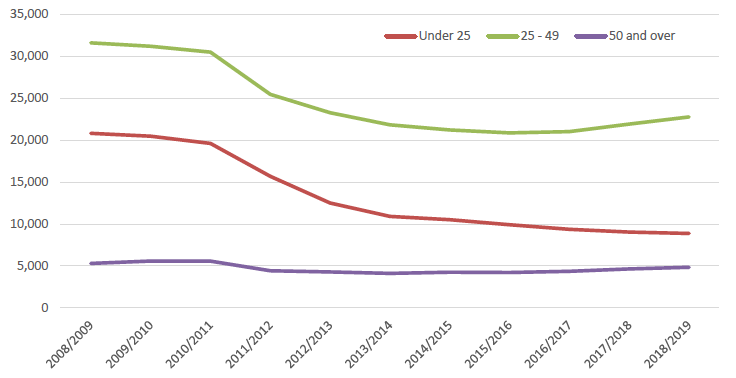
However, when comparing to the proportion of households in Scotland headed by someone of this age[5], this younger age group are over represented, as only 5% of households in Scotland are headed by someone aged 16 to 24 years old. It should be acknowledged however that the majority of under 25’s making a homelessness application lived with friends, relatives and partners prior to becoming homeless (Table 3), so would not always be considered a head of household.
Conversely, the proportion of applications from over 50’s has been increasing, from 9% in 2008/09 to 13% in 2018/19. For this group the number of applications received has been a lot more stable, with just a 9% reduction over the last decade. However, when comparing to the proportion of households in Scotland headed by someone of this age, this older age group are under represented, as 55% of all households in Scotland are headed by someone aged 50 and over[3].
The same trends are apparent in other parts of the UK too[6].
A lower proportion of older adults make homeless applications
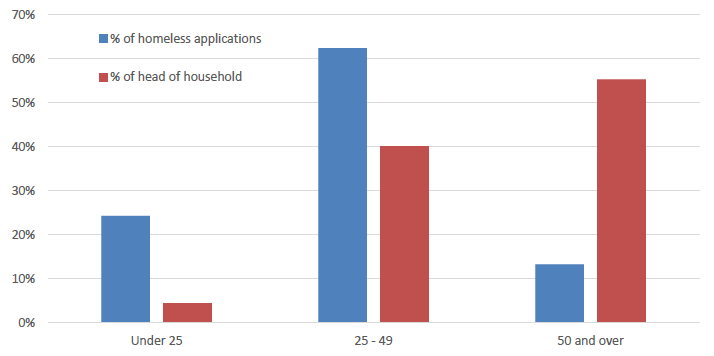
Gender[7] (Table 1b and 1c)
During 2018/19 just over half (54%) of homelessness applications had a main applicant who was male. The gender split of main applicants has remained relatively stable for the past decade, with male main applicants always accounting for a slightly higher proportion than female main applicants. The proportion of male main applicants has fluctuated between 52% and 55% over the last decade.
Table 1c shows that in 2018/19 almost half (45%) of homelessness applications came from single male households, while single female households account for 21% of applications. Female single parents make up a larger proportion of applications than male single parents however, with 17% compared to 4%.
Over the last decade there has been an increase in the proportion of applications from single males, from 40% in 2008/09 to 45% in 2018/19. This may be partly due to the abolition of the Priority Need Test in December 2012, which meant all unintentionally homeless households were entitled to settled accommodation.[8]
In 2018/19 single males represented 45% of all homeless applications
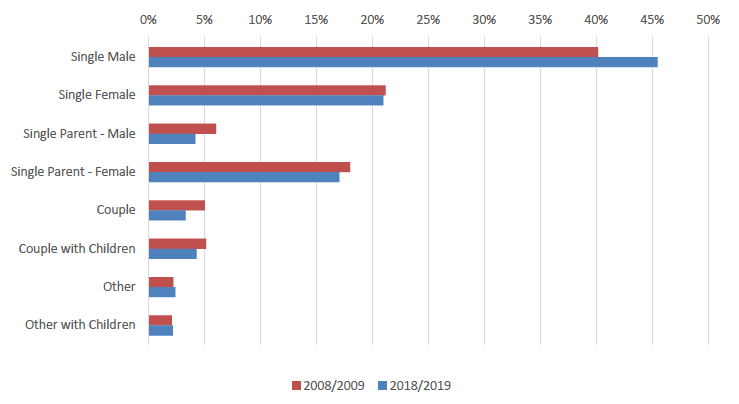
Ethnicity (Table 1d)
During 2018/19, 88% of main applicants were of White ethnicity (76% were of White Scottish ethnicity). By comparison 95% of the Scottish population are of white ethnicity (77% White Scottish).[9]
Over the last decade the proportion of homelessness applications from main applicants of White Scottish ethnicity has reduced from 85% in 2008/09 to 76% in 2018/19. The proportion of those identifying themselves as in Other ethnic group has increased over time, from about 2% in 2008/09 to about 4% in 2018/19.
The majority of homeless of applicants were of White Scottish ethnicity
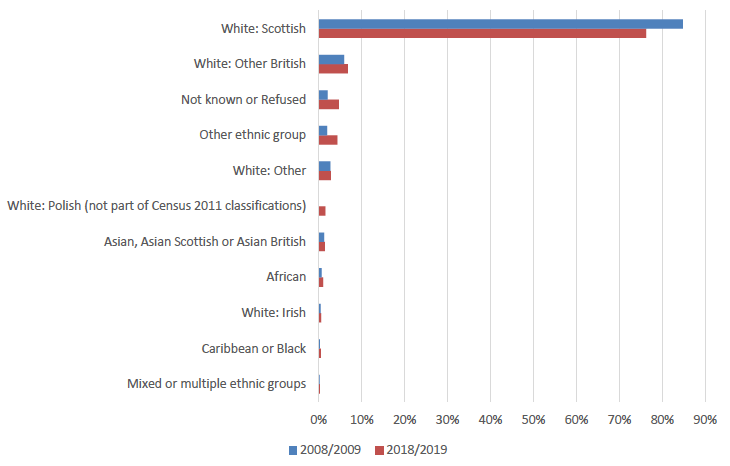
Rough sleeping (Table 2)
During 2018/19 the proportion of applications where a household member reported sleeping rough at least once during the last 3 months prior to application was 8% and the number sleeping rough the night before application was 5%.
The majority of applicants where at least one member of the household slept rough either in the 3 months preceding applying or the night before, were single males (74% and 78% respectively). 13% of single male applicants reported sleeping rough at least once in the preceding 3 months and 8% reported sleeping rough the night before the application during 2018/19.
While applicants from households including children accounted for 10% of those reporting a household member sleeping rough in the three months prior to their application, and 4% of applicants for the the night before their application, this does not necessarily indicate that the children within the household slept rough.
74% of households who slept rough in the three months prior to their application were single males
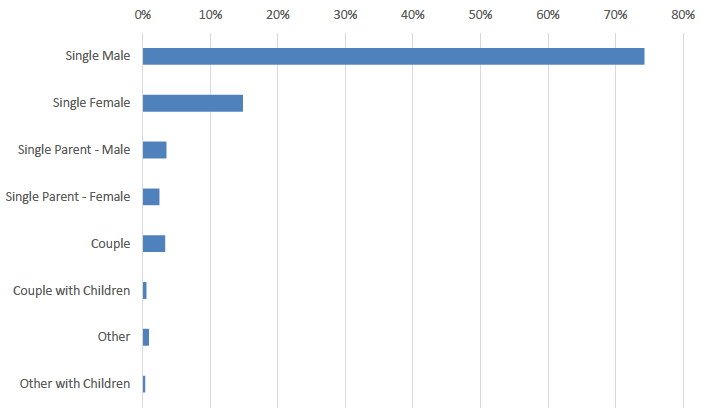
Applicants who reported rough sleeping prior to their application were more likely to be aged 25 to 49, with 68% of applications who reported sleeping rough in the three months prior to their application belonging to this age range.
Applicants of White Irish ethnicity were the most likely to report rough sleeping prior to their application, with 16% reporting sleeping rough in the three months prior to their application and 13% the night before. This compares to 8% of all applicants reporting sleeping rough in the three months prior to their application and 5% the night before. However it should be noted that applicants of White Irish ethnicity make up a small proportion (1%) of all applications.
Prior circumstances of applicants (Table 3)
Of the 36,465 homelessness applications in 2018/19, 15,202 (42%) had been living with friends, relatives and partners, while 13,966 (38%) had been living in their own accommodation (i.e. which they either rented or owned).
Younger homeless applicants are far more likely to have been living with friends, relatives and partners, than older applicants. With 62% of main applicants who were under 25 having lived with friends, relatives and partners compared to 29% of main applicants who were 50 and over. Over half (52%) of main applicants who were 50 and over owned or rented the accommodation they became homeless from, compared to 21% of applicants aged under 25.
Older applicants are more likely to own or rent the property they become homeless from
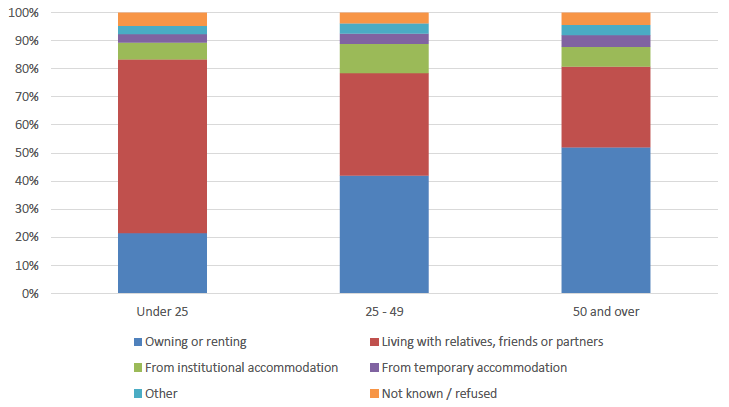
Single males, single females and male single parents are much more likely than other household types to have been living with friends, relatives and partners before becoming homeless. The majority of households including children (56%) had been living in their own accommodation, with 30% living in private rented accommodation. This compares to 12% of households without children living in private rented accommodation.
There is not much variation in prior circumstances of applicants of different ethnicities. Apart from, 37% of applicants identifying as Other ethnic group reporting living in Supported Accommodation prior to applying as homeless, compared to 3% of all applications. 98% of these applicants are not EU nationals but have been granted refugee status or leave to remain, therefore it is highly likely that they have left the accommodation provided by the Home Office (recorded here are Support Accommodation) whilst their status was considered and are then presenting as homeless.
Reasons for homelessness (Tables 6 and 7)
The most common reason for all homelessness applications is that the applicant household has been aked to leave their current accommodation (25%). For younger applicants, this is even more likely. For those aged 16-17, this is the reason for over half (55%) of homelessness applications, whereas for those aged 65 and over it accounts for only 14% of applications.
For female main applicants, the most common reason for making a homelessness application is a violent or abusive dispute within the household, this accounts for 22% of all applications from female main applicants and compares to just 5% of applications from male main applicants. 21% single females making a homelessness application state this as the main reason for doing so and 27% of female single parents.
Applicants of Asian, Asian Scottish or Asian British ethnicity are most likely to state the reason for their homelessness application as a violent or abusive dispute within the household. This accounts for 23% of all applications from Asian, Asian Scottish or Asian British applicants and compares to 13% of all applications. 88% of these are from female main applicants, this accounts for the main reason for homelessness for 41% of female Asian, Asian Scottish or Asian British applicants.
As the causes of homelessness can be complex and not the result of a single incident or event, 67% of applications cited additional reasons for making an application. The most common additional reason for all but the 16-17 age group, was ‘not to do with applicant household (e.g. landlord selling property, fire, circumstances of other persons sharing previous property, harassment by others, etc)’. However, for main applicants aged 16-17 the most common additional reason for homelessness was lack of support from friends and family.
Over 50’s were much more likely to report a physical health reason as an additional reason for their homeless application. 25% of main applicants who were 50 and over did so, compared to 7% of those under 50.
Almost two thirds (65%) of applicants who were couples with children reported unmet need for support from housing/ social work/ health services as an additional reason for their homelessness application.
82% of applicants from Other ethnic group cited additional reasons for making a homelessness application, this compares to 67% of all applications. Of those citing an additional reason 81% of those of an Other ethnic group reported unmet need for support from housing/ social work/ health services as an additional reason for their homelessness application. This may be related to the fact that 60% of applicants of Other ethnic group ethnicity are not EU nationals but have been granted refugee status or leave to remain.
Contact
There is a problem
Thanks for your feedback